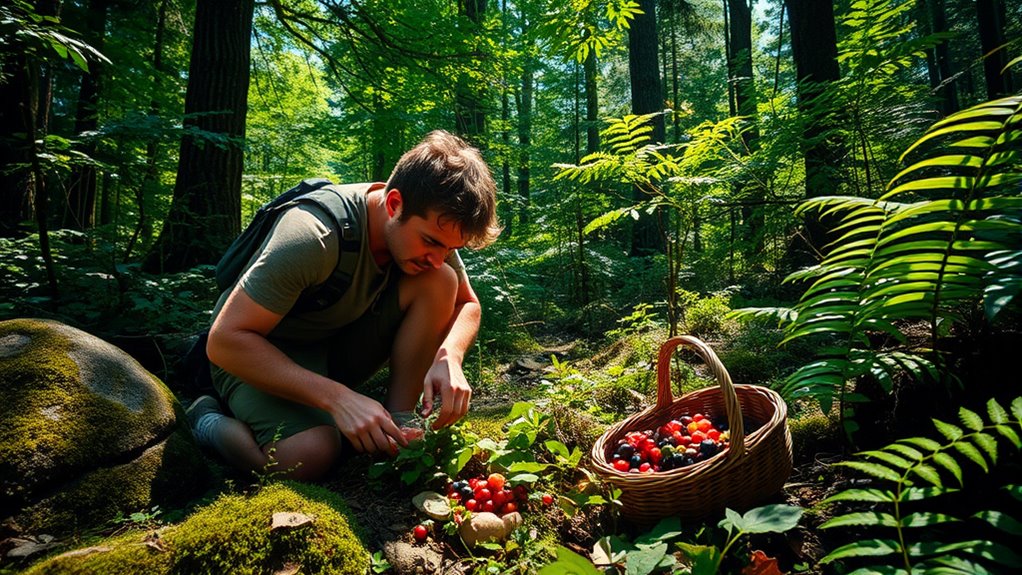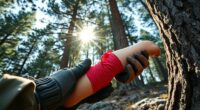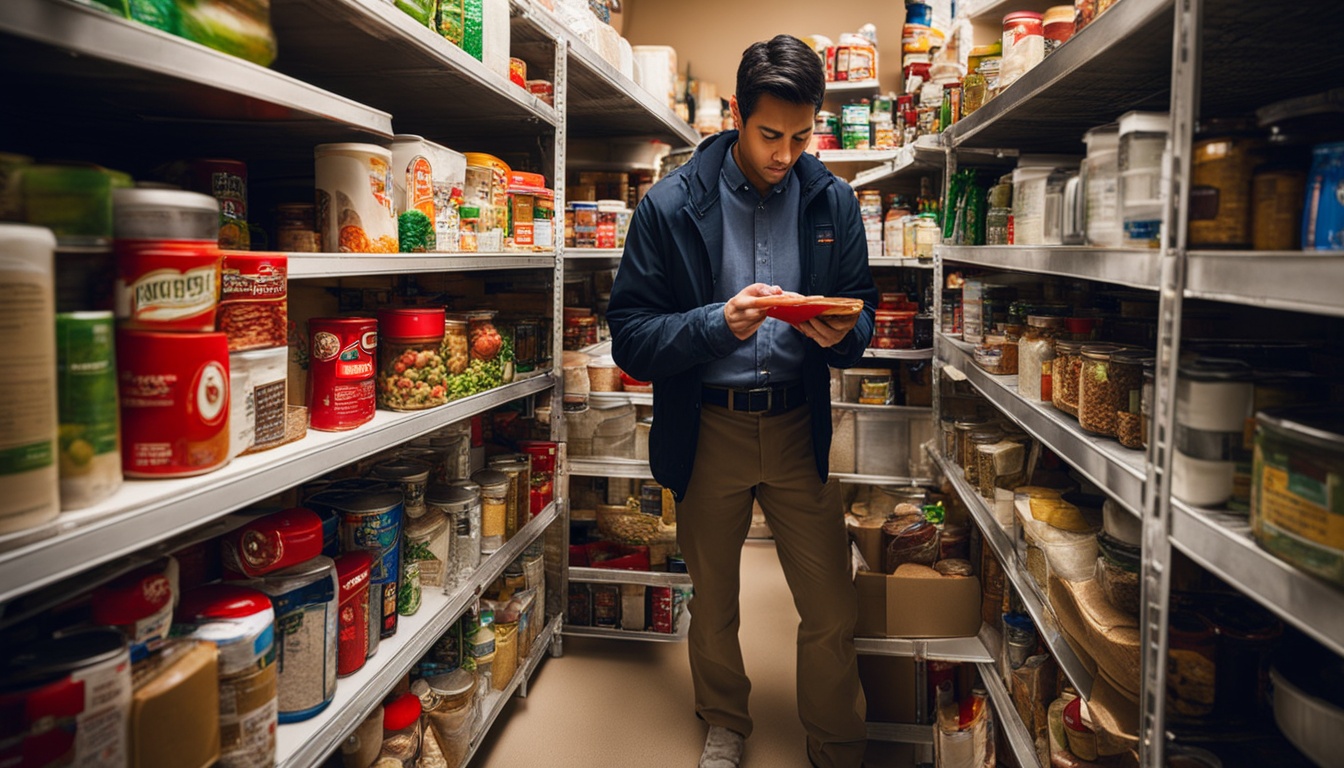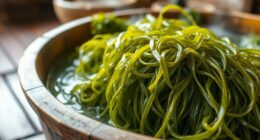In survival situations, start by accurately identifying safe wild edibles like berries, greens, insects, and aquatic foods, avoiding toxic plants with milky sap, spines, or umbrella-shaped flowers. Use reliable tools and guides, practice sustainable harvesting, and prepare foods properly to prevent poisoning. Follow seasonal cues to find the best options and learn preservation techniques for extended shelf life. If you want to master these skills, further tips will help you confidently forage in the wild.
Key Takeaways
- Identify safe wild edibles by observing leaf shape, flower structure, habitat, and avoiding toxicity indicators like milky sap or spines.
- Use reliable resources and tools such as field guides, apps, and local expertise to accurately distinguish edible from poisonous plants.
- Harvest only necessary parts during peak season, practicing sustainable foraging to prevent ecosystem damage.
- Collect marine and aquatic foods like seaweed and shellfish carefully, ensuring proper identification and thorough cooking for safety.
- Preserve foraged foods through drying, fermenting, or canning to extend shelf life and ensure nutrition during scarcity.
Understanding the Basics of Edible Plants and Creatures
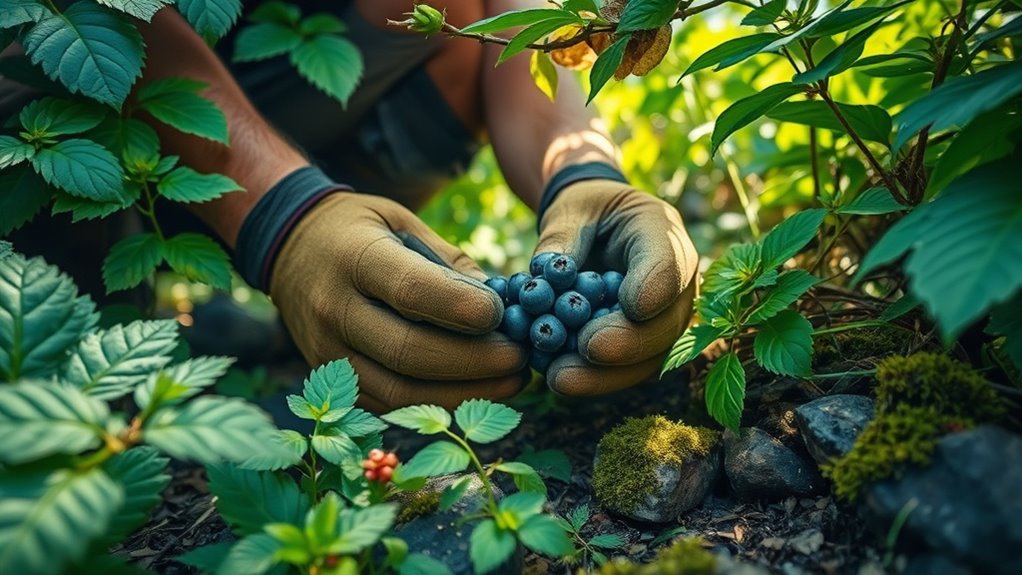
Have you ever wondered which wild plants and creatures can sustain you in a survival situation? Learning about edible plants and foraging is essential for survival food sources. Many wild edibles, like acorns, cattails, chickweed, and violets, are easy to identify and offer vital nutrients. You can also find edible creatures such as insects—crickets and grasshoppers—that provide a high-protein survival food. However, proper identification is crucial because many edible plants have toxic look-alikes, like certain mushrooms or plants with milky sap. To stay safe, observe specific features like leaf shape, flower structure, and habitat, and use field guides or expert resources. Recognizing these basics helps you confidently find wild edibles that can sustain you when options are limited. Understanding foraging range and environmental factors can also help you locate resources more effectively in your surroundings.
Recognizing Toxic Plants and How to Avoid Them

To stay safe while foraging, learn to spot common toxic plant indicators like milky sap, spines, or waxy leaves. Use reliable sources to verify plant identification before eating, especially if the plant has umbrella-shaped flowers or strong odors. Never eat a wild plant unless you’re absolutely certain it’s safe; misidentification can be deadly. Additionally, understanding color accuracy in plant appearance can help distinguish edible from toxic species. Recognizing plant toxicity signs such as unusual markings or odors can further prevent accidental ingestion of harmful plants. Being aware of essential oil properties may also help identify plants with potential medicinal or toxic effects before consumption. Proper knowledge of remote work productivity strategies can keep you alert and focused during your foraging expeditions, especially in unfamiliar environments. Incorporating ethical hacking principles such as thorough reconnaissance and verification can also be applied to ensure you identify plants correctly and avoid dangerous mistakes.
Common Toxic Plant Indicators
Recognizing toxic plants in the wild is essential for safe foraging, as many poisonous species display distinct indicators. Warning signs include plants with milky or latex sap, like pokeweed or milkweed, which often signal toxicity. Waxy, shiny, or smooth leaves can be a warning sign of poisonous plants such as deadly nightshade or certain hemlocks. Plants with fine hairs, spines, or thorns, like poison ivy or poison oak, serve as natural defense mechanisms and can be toxic if touched or ingested. Umbrella-shaped flower clusters, like water hemlock or poison hemlock, are strong indicators of highly toxic species. Bright-colored berries or clustered fruits, such as baneberry or holly, also warn of poisonous plants. Proper plant identification is vital to avoid accidental poisoning. Additionally, some plants with a high horsepower or rapid growth rate may be mistaken for edible species but can be highly toxic, so thorough knowledge is crucial. Recognizing angel numbers as patterns or signals from the universe can help increase awareness and improve decision-making in outdoor survival situations. Moreover, understanding the distinctive plant features can aid in distinguishing between toxic and safe plants more effectively. Being familiar with natural plant defenses, such as spines or bitter tastes, further supports safe foraging practices.
Accurate Identification Techniques
Accurate identification of wild plants hinges on observing specific features that distinguish safe species from toxic look-alikes. To master plant identification, you should:
- Look for common toxic plant indicators like milky or latex sap, fine hairs, spines, or shiny, waxy leaves.
- Avoid plants with umbrella-shaped flower clusters, which often signal toxic species such as water hemlock.
- Learn to differentiate safe wild edibles by examining unique parts, such as flat, fan-shaped Iris leaves versus upright cattails.
Using these foraging techniques helps prevent misidentification, which is vital when foraging for food in survival situations. Always verify plant identification through multiple sources before consuming any wild edibles, and when in doubt, refrain from eating and seek expert confirmation.
Safe Foraging Practices
When foraging for wild plants, identifying potential dangers is essential to avoid toxic species. Always confirm that a plant is edible with multiple reputable sources before consuming it. Avoid plants with milky or latex sap, spines, or fine hairs, as these are common signs of toxicity. Be cautious of umbrella-shaped flower clusters, which often indicate poisonous species, especially if you can’t identify them confidently. Never eat a plant unless you’re 100% sure it’s safe; when in doubt, opt for well-known edible options. Remember that certain parts, like roots or seeds, can be more toxic than leaves or flowers. Practicing these safe foraging habits helps ensure your survival food is both nutritious and harmless. Additionally, understanding Fokos can provide valuable insights into risk assessment and safe foraging practices in survival situations. Developing foraging skills through practice enhances your ability to correctly identify safe plants and avoid dangerous ones. Incorporating knowledge of vetted sources can further improve your identification accuracy and safety. Being aware of AI technology advancements can also aid in identifying plants more accurately through portable devices, increasing your confidence in wild foraging.
Essential Tools and Resources for Foraging

To forage effectively, you need the right tools and resources at hand. A sharp knife or multi-tool helps you harvest plants cleanly, while containers like baskets or mesh bags keep your finds fresh. Reliable identification guides make sure you can distinguish edible plants from poisonous ones with confidence. Investing in forage 100 resources can further improve your foraging success and safety. Additionally, learning local flora can enhance your ability to identify safe and nutritious plants specific to your environment. Recognizing economic downturn resilience in your foraging strategy can help you adapt to changing conditions and ensure a sustainable food source. Keeping up with candy vending machine trends might also inspire creative ways to store or utilize foraged foods in emergency situations.
Essential Foraging Tools
Having the right tools is vital for safe and efficient foraging in survival situations. First, a sharp knife or multi-tool is essential for harvesting plants and cutting roots safely. Second, baskets, mesh bags, or cloth sacks help you collect and carry foraged items without damaging delicate parts. Third, gloves protect your hands from thorns, irritants, and toxins when handling wild plants. Additionally, reliable identification resources like field guides, apps, or laminated cards are invaluable for distinguishing edible from toxic plants. Employing proper identification techniques ensures you can forage effectively while minimizing risks. These tools guarantee you can gather food safely in the wild with a sturdy knife, suitable containers, and edible plant identification resources. Using sustainable foraging practices helps preserve natural resources for future foragers.
Reliable Identification Resources
Equipping yourself with reliable identification resources guarantees you can confidently distinguish edible plants from toxic ones in the wild. Use reputable field guides like Peterson’s Guide to Edible Wild Plants or regional flora books to assure accurate identification. Plant identification apps such as Wild Edibles or iNaturalist provide real-time species recognition and community verification, enhancing your foraging accuracy. Participating in local foraging classes or workshops offers hands-on experience and expert guidance tailored to your area. Online forums and resources are also invaluable, especially when they include detailed photos and habitat descriptions. Additionally, invest in a good magnifying glass and a portable plant key or dichotomous key to examine plant features closely in the field. These foraging resources are essential for safe, effective wild food gathering.
Seasonal Wild Edibles and Their Uses

Throughout the year, foraging for wild edibles aligns with seasonal changes, offering a diverse array of plants at their peak flavor and nutritional value. During spring, you’ll find young leaves of wintercress and chickweed, which can be eaten raw or cooked for maximum flavor. In summer, wild berries like raspberries and elderberries become ripe food sources, alongside cattail pollen and acorns after leaching tannins. Fall is prime for harvesting pine nuts, hickory nuts, and acorns, plus root vegetables like waterlily tubers and arrowhead rhizomes. In winter, hardy greens such as watercress and evergreen needles, like pine, provide essential nutrients. Key to seasonal foraging is harvesting specific plant parts at their prime, ensuring the best edibility and flavor from your wild edible plants.
Harvesting Techniques for Safe and Sustainable Gathering
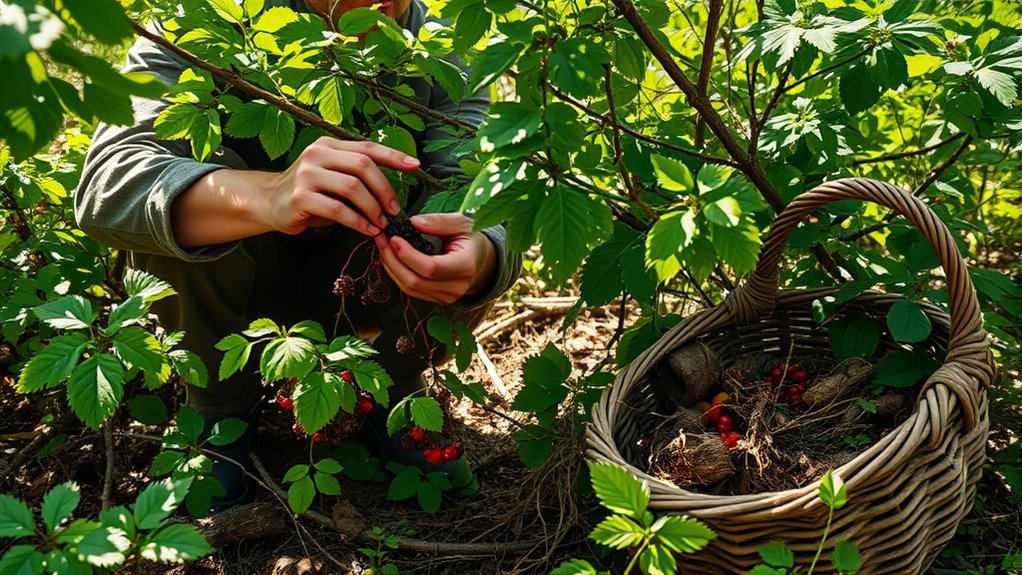
To harvest effectively, you need to identify plants correctly to avoid dangerous look-alikes. Use proper tools and gentle techniques to collect only what’s needed, ensuring you don’t harm the plant or ecosystem. Always handle edible parts carefully and follow seasonal timing to promote sustainable gathering.
Proper Plant Identification
Proper plant identification is essential for safe and sustainable foraging, as many edible wild plants have toxic look-alikes. To confidently identify plants, you should:
- Consult multiple reliable sources, such as field guides, expert opinions, and visual comparisons.
- Focus on harvesting specific, identifiable plant parts like leaves, roots, or seeds, avoiding the whole plant.
- Learn to distinguish edible wild plants by examining features like leaf shape, vein patterns, flower structures, and growth habits.
Sustainable Harvesting Methods
Implementing sustainable harvesting methods guarantees you gather wild foods responsibly without harming the environment. Use careful techniques like a digging stick or trowel to extract roots and tubers, minimizing damage and supporting plant regeneration. Always harvest only mature parts, such as fully developed seeds or leaves, to prevent overharvesting and promote ongoing growth. Collect only about a quarter of a plant or seed head, ensuring the local population remains healthy. When gathering from trees or shrubs, gently pick ripe fruits, flowers, or seeds without stripping everything, maintaining the plant’s reproductive capacity. Leave some plant parts behind, like seed heads or flower stalks, to enable natural reproduction. These harvesting methods help maintain ecosystem balance while ensuring sustainable food sources for future foraging.
Safe Handling Practices
Using careful handling techniques guarantees that your harvesting remains both safe for you and sustainable for the environment. Always use sharp tools like scissors or knives to prevent tearing and minimize plant damage. When harvesting, follow these steps:
- Use sharp tools to ensure clean cuts, avoiding bruising or breaking the plant.
- Collect only what you need, such as young leaves or seeds, to support sustainable harvesting.
- Harvest from areas free of pollutants, like roads or industrial zones, to reduce chemical exposure.
Treat plants gently to prevent spoilage and maintain nutritional value. By practicing these techniques, you protect yourself from injury and help the environment thrive. Proper harvesting ensures your survival food remains safe and sustainable.
Identifying and Preparing Marine and Aquatic Food Sources

To effectively forage for marine and aquatic food sources, you need to learn how to identify edible species in their natural environment. Look for healthy, unpolluted waters and avoid species with damaged shells or unusual colors. Focus on edible marine food like seaweed, clams, and mollusks, which thrive in intertidal zones. Proper preparation is essential: rinse seaweed to remove debris, boil or dry it, and thoroughly cook clams and mollusks to eliminate toxins and parasites. Use this table to guide your identification and preparation:
| Marine Food | Identification Tips | Preparation Method |
|---|---|---|
| Seaweed | Bright green, unbroken | Rinse, boil, dry |
| Clams | Firm shell, no damage | Boil thoroughly |
| Mollusks | Healthy appearance, no debris | Cook completely |
| Crustaceans | Active movement, intact shell | Boil or steam |
Incorporating Insects Into Your Foraging Diet

In survival situations, incorporating insects into your diet can provide an essential and sustainable protein source. Edible insects like crickets, grasshoppers, and mealworms pack nutrients such as vitamins and minerals. To safely forage, follow these tips:
- Look for insects with dull colors and avoid brightly colored or hairy ones, which may be toxic.
- Properly cook insects by roasting or boiling to kill parasites and improve digestion.
- Harvest insects near plants, under rocks, or on tree trunks, making foraging easier and more effective.
Locating and Utilizing Local Wild Plants
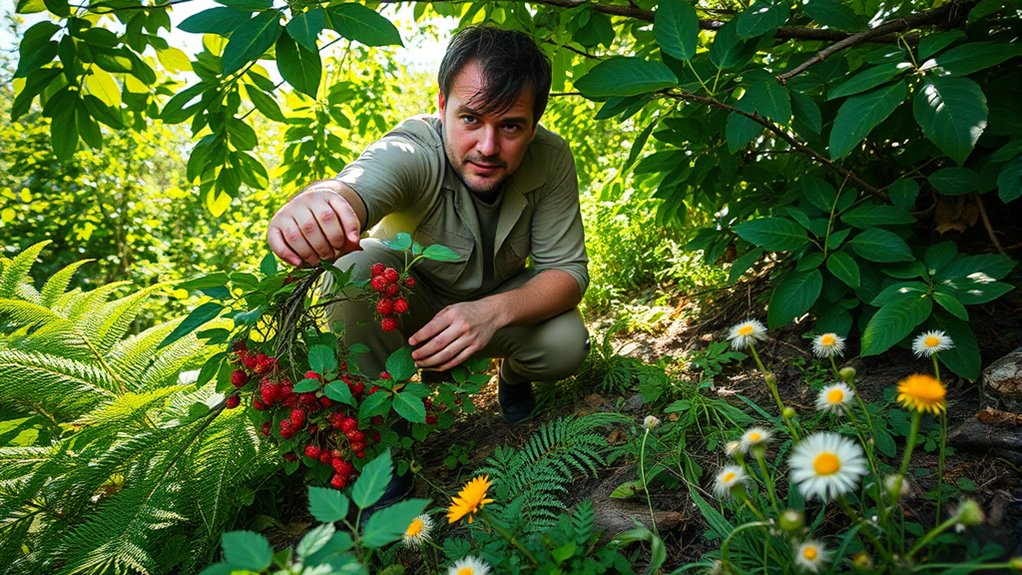
Finding and utilizing local wild plants begins with knowing which species are safe and abundant in your area. In survival situations, effective foraging relies on recognizing edible wild plants like waterlilies, cattails, wild greens, and native berries. Use field guides, local resources, or apps to learn their appearance, habitat, and seasonality. Always harvest from pollution-free environments, avoiding areas near roads, farms, or industrial sites. Focus on collecting specific edible parts such as roots, seeds, leaves, or flowers, and practice sustainable harvesting by taking only what you need. Explore different terrains like wetlands, forests, and open fields to find a diverse range of edible wild plants. Proper identification and mindful harvesting are essential for safe and successful foraging in survival situations.
Cooking and Preserving Wild Foods for Longevity

Once you’ve gathered wild foods, preserving them properly guarantees they last longer and stay safe to eat. To do this effectively, you should consider these methods:
- Drying: Sun or low heat drying dehydrates herbs, fruits, and vegetables, concentrating flavors and nutrients for long-term storage.
- Fermentation: This process not only preserves vegetables and fruits but also boosts probiotic content, improving digestion and immune health.
- Canning: Sealing wild foods in airtight jars through boiling water or pressure canning preserves them for months or years when done correctly.
These preserving techniques prevent spoilage, extend shelf life, and ensure you have access to nutritious wild foods during times of scarcity. Proper preservation is essential for survival success.
Developing Your Foraging Skills and Knowledge

Developing your foraging skills and knowledge is essential for safely identifying edible plants and avoiding poisonous ones. To improve your plant identification, regularly practice in your local environment using field guides, focusing on key features that differentiate safe, edible plants from harmful ones. Start with easily recognizable, abundant species like dandelions, clover, and wild berries to build confidence and expand your knowledge. Attending foraging workshops or survival courses, such as Willow Haven Outdoors’ Skills Day, provides hands-on experience with safe harvesting and preparation techniques. Keep a foraging journal with sketches, photos, and notes about plant habitats, seasonal changes, and edible options. Using digital resources like mobile apps and online guides helps verify identifications and discover new edible plants in your region, strengthening your wilderness survival skills.
Frequently Asked Questions
How to Forage for Food in the Wilderness?
When foraging in the wilderness, you should start by learning to identify common edible plants like chickweed, dandelion, and wild berries. Use reliable guides or apps to confirm your finds and avoid poisonous look-alikes. Harvest only specific parts of plants, taking just a little to prevent harm and ensure sustainability. Always forage away from polluted areas and follow local regulations to safeguard the environment and your health.
How to Find Food in a Survival Situation?
In a survival situation, you find food by spotting easily recognizable plants like berries, greens, and grasses. You locate water sources such as streams or ponds, which often have edible aquatic plants. Pay attention to seasonal cues like flowering and seed dispersal to harvest at the right time. Look for edible trees and shrubs, and always practice sustainable foraging to guarantee you don’t deplete essential resources.
Can You Survive by Foraging?
You can survive by foraging if you know which wild foods are safe and nutritious. By correctly identifying plants like acorns, cattails, and waterlilies, along with insects and crustaceans, you’ll get essential nutrients. Proper preparation and sustainable harvesting are key. With the right knowledge and adaptability, you can maintain your health and meet your energy needs through foraging, even in challenging situations.
Is Foraging for Food Illegal?
You wonder if foraging for food is illegal. It depends on where you are. In many areas, harvesting wild plants without permission on private property or protected lands is against the law. You need to check local regulations, as some places require permits or prohibit foraging altogether. Ignoring these rules can lead to fines or legal trouble, so always research and follow the laws to stay safe and legal.
Which Type of Society Survives Mainly by Foraging for Food?
You’re asking which society mainly survives by foraging for food. Hunter-gatherer societies primarily rely on foraging, hunting, and fishing to meet their daily needs. These groups, like the San people or Pacific Northwest tribes, depend on their ecological knowledge to sustainably harvest wild resources. By moving seasonally and understanding their environment, they guarantee their survival without agriculture, emphasizing a deep connection to and respect for nature.
Conclusion
As you master foraging, you’ll find yourself amid nature’s bounty, a stark contrast to the sterile aisles of supermarkets. With each edible leaf and insect, you embrace freedom and self-reliance, transforming uncertainty into confidence. Though the wild offers sustenance, it also demands respect and caution. By honing your skills, you turn survival into an art—where wild abundance becomes not just food, but a connection to the land that sustains you.

